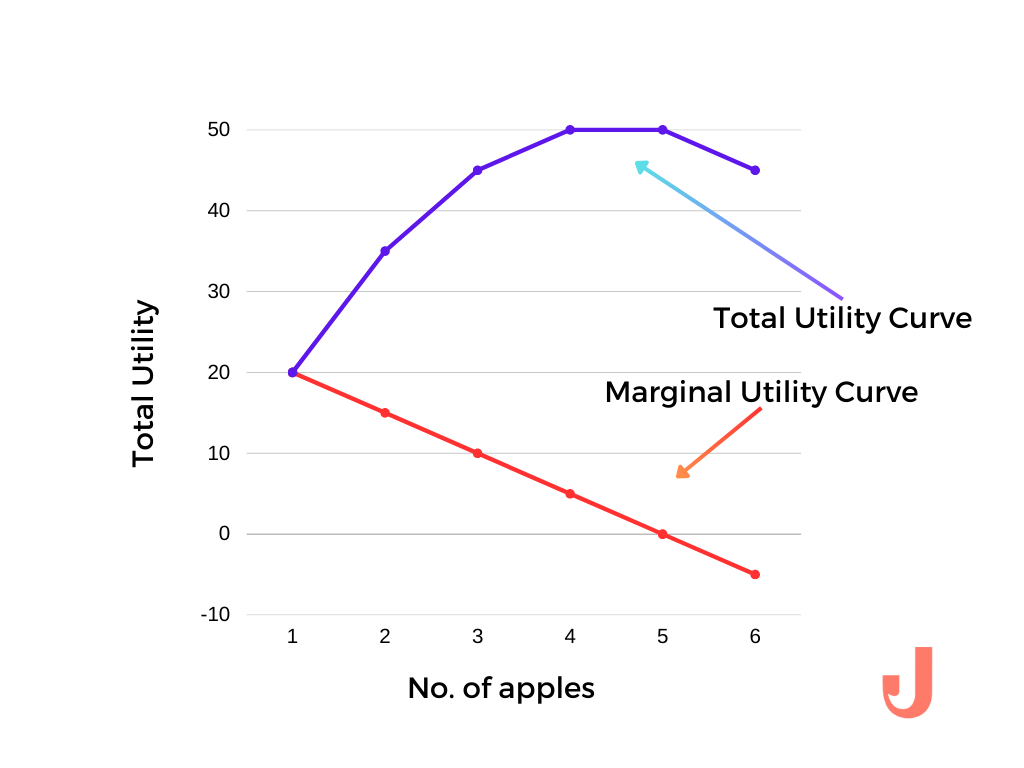

Get salary accounts for your team See benefits


Table of Contents
ToggleThe Law of Diminishing Marginal Utility states that as a person consumes more of a good or service, the additional satisfaction (or utility) they derive from each additional unit decreases.
In simpler terms, the more of something you have, the less you value each additional unit. For example, the first slice of pizza might be incredibly satisfying, but as you eat more slices, your enjoyment of each additional slice gradually decreases.
For example, you have a packet of candies from which you consume three candies, which may delight your taste buds. However, after consuming nine to ten pieces, it may not be as delightful as the first three pieces consumed at the beginning
Marginal Utility (MU) is the additional satisfaction a consumer gets from consuming one more unit of a good.
MU = Marginal Utility
ΔTU = Change in Total Utility
ΔQ = Change in Quantity Consumed
Human wants are based on a characteristic of intensity. As we consume more of a commodity in succession, marginal utility from consumption of each additional unit of the commodity decreases. Below mentioned are some reasons that justify the importance of the Law of Diminishing Marginal Utility:
How Businesses use DMU law?
This principle helps businesses decide how much of a product to be offered and at what price. When companies know that customers get less satisfaction with each extra unit consumption, they can plan discounts, bundle offers, or offer product variations to keep interest high. For example, fast food combos or “buy one get one” deals use this logic to keep customers happy while increasing sales.
The Assumptions of the Law of Diminishing Marginal Utility are:
Let’s assume that a person consumes six apples. The first apple consumed gives him 20 utils (util is a term used to measure utility). In contrast, the second and third apple consumed decreases the marginal utility with each additional apple consumed. This is because their desire to consume more apples decreases with each successive unit of apple consumed.
Let’s understand this concept more clearly with the help of a schedule and diagram:
Schedule for Law of Diminishing Marginal Utility:
| Units of Consumptions | Total Utility | Marginal Utility |
| 1 | 20 | 20 |
| 2 | 35 | 15 |
| 3 | 45 | 10 |
| 4 | 50 | 5 |
| 5 | 50 | 0 |
| 6 | 45 | -5 |
In the schedule above, the total utility from the consumption of the first apple is 20 utils, which keeps on increasing until the person reaches their saturation point, i.e., the fifth apple. On the other hand, the marginal utility from the consumption of each additional apple keeps on diminishing. Upon the consumption of the sixth apple, the person has gone over the limit, and the marginal utility becomes negative, which results in a decrease in the total utility. Here is a diagram representation based on the schedule.

As per the Law of Diminishing Marginal Utility, the marginal utility of a commodity diminishes upon the consumption of each successive unit, although total utility does not change. Here is an example of how the Law of Diminishing Marginal Utility works.
A hungry man decides to purchase five chapatis. Once the man consumes the first chapati, he gains a positive utility because he was quite hungry, and the first chapati was the first thing he consumed. Therefore, the marginal utility of the consumption of the first chapati will be high.
Upon eating the second chapati, the man’s appetite is further satisfied. His stomach started getting full. The man may not be as starved as he was before. Hence, the second chapati may offer less interest and relief than the first chapati. The marginal utility from consuming the second chapati may increase at a diminishing rate. Upon consumption of the third chapati, the marginal utility may diminish even more as the man’s hunger is further satisfied.
Consumption of the fourth chapati may also experience even less marginal utility, and the man may feel discomfort from consuming more chapatis as his hunger is being satisfied. Finally, the consumption of the fifth chapati may not be possible as the man may feel full from consuming all the four chapatis. Hence the marginal utility from the fifth chapati may result in negative utility.
With the example mentioned above, five chapatis represent the ‘Law of Diminishing Marginal Utility’, which clearly states that more and more consumption of each successive unit of commodity results in diminishing marginal utility from each additional unit of commodity consumed. In a business, a company may benefit from having two accountants. However, if there is no requirement for an additional accountant in the company, hiring one may result in diminishing marginal utility.
Different types of marginal utilities are as mentioned below:
The Law of Diminishing Marginal Utility explains how the satisfaction you get from consuming additional units of a good tends to decrease as you have more of it. However, there are several situations where this law doesn’t apply:
Mentioned below are the significant differences between Total Utility and Marginal Utility:
| Parameters | Marginal Utility | Total Utility |
| Meaning | Marginal utility refers to the amount of satisfaction derived from the consumption of a commodity. | Total utility refers to the amount of satisfaction the consumer derives from the consumption of every additional unit of the commodity. |
| Rate of increase | Marginal utility decreases with an increase in total utility. | Total utility increases when the consumption is done. |
| Results | Marginal utility decreases with the consumption of each successive unit of commodity. | The total utility gets affected by diminishing returns. |
Priyanka Rao is a content strategist for Jupiter.Money, and specializes in writing on topics related to finance, banking, budgeting, salary & wages, and other financial matters. She has a passion for creating engaging content that resonates with audiences across various digital platforms. In her free time, Priyanka enjoys traveling and reading, which allows her to gain new perspectives and inspiration for her work. With a keen eye for detail and a creative mindset, Priyanka is committed to creating content that connects well with her readers, enhancing their digital experiences.

Powerd by Issued by
